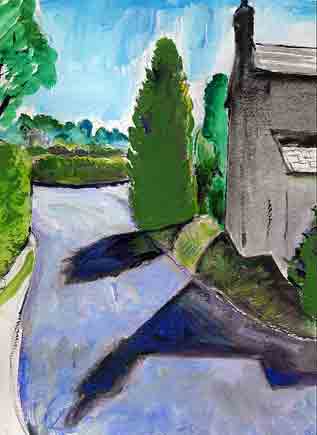The Lyme Maze Game

Cook's Lane starts by descending sharply to rejoin its former bed, at a farmhouse. Then it goes along roughly level for half a mile, trending leftward around the embayment of a valley head that looks down toward Axminster. In a narrow stretch of the lane you may notice that the hedges on both sides are ornamented with myriad wisps of straw. Evidently a farm vehicle has squeezed through with a tall load. I'm usually so hot by the time I'm riding along here that I halt to strip off shirt and shoes, and one time I hung my bicycle helmet on the handlebar and rode on, and it got lost and I never found it. So let me know if you discover a red helmet among the weeds. The lane makes a wriggle where it throws off to the right a bridleway called Pidgeon's Lane.
After this it gradually ascends the slope, and becomes lined on the right with the bungalows of a sort of floating suburb called Raymond's Hill. (If a suburb is to a town as a planet is to a star, then a floating suburb is like one of those planets that may wander in the gulfs between the stars.) Cook's Lane rises with a final rightward twist up to a junction.
This is a locality that used to be called the Six-Cross (though it isn't marked on maps that way). The straight and level Crewkerne Road runs past, and several lesser lanes, including the one you have come along, branch off from it about here. The Six-Cross no longer looks like a six-way junction, because it has become a long formation distributed in two parts. Here, Cook's Lane comes up to the Crewkerne Road on one side and Green Lane slants off on the other side; a hundred yards away to the left is where the other two side-lanes take off. (They pass either side of the head of the valley in which lies Monkton Wyld, so this point is called Monkton Wyld Cross.) Added now between these two nodes is a seventh branch, a small "close" of recent houses. "You wouldn't have lived there back then", says an old-timer, speaking of the middle twentieth century; "it was Gypsyland." The Six-Cross seasonally became a "Gypsy village" of ten or twelve caravans. I'm not sure where the open ground was—perhaps spread along between the two parts of the Six-Cross—but it's now mostly treed. The Gypsies came up from Cornwall where they'd had spring work picking daffodils, helped on the farms around here, moved on to apple-picking in Kent. The unregulated world of the free people is gone, and now it's suburban Raymond's Hill. You can go along the Crewkerne Road rightward ==. Or leftward along it to the other half of the Six-Cross ==. Or across it into Green Lane. |

